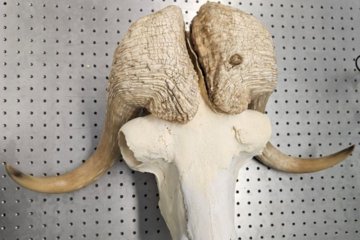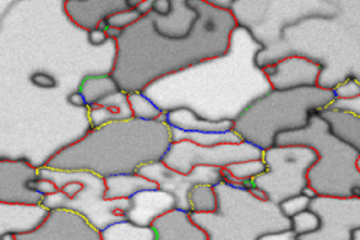All genres
481.
Journal Article
Phase stability of non-equiatomic CoCrFeMnNi high entropy alloys. Acta Materialia 98, pp. 288 - 296 (2015)
482.
Journal Article
Quantitative chemical-structure evaluation using atom probe tomography: Short-range order analysis of Fe–Al. Ultramicroscopy 157, pp. 12 - 20 (2015)
483.
Journal Article
From High-Entropy Alloys to High-Entropy Steels. Steel Research International 86 (10), pp. 1127 - 1138 (2015)
484.
Journal Article
Rapid theory-guided prototyping of ductile Mg alloys: from binary to multi-component materials. New Journal of Physics 17 (9), 093009 (2015)
485.
Journal Article
Microstructure design and mechanical properties in a near-a Ti–4Mo alloy. Acta Materialia 97, pp. 291 - 304 (2015)
486.
Journal Article
Linear complexions: Confined chemical and structural states at dislocations. Science 349 (6252), pp. 1080 - 1083 (2015)
487.
Journal Article
Synergy of atom-probe structural data and quantum-mechanical calculations in a theory-guided design of extreme-stiffness superlattices containing metastable phases. New Journal of Physics 17 (9), 093004 (2015)
488.
Journal Article
Self-Assembled Monolayers: Star-Shaped Crystallographic Cracking of Localized Nanoporous Defects (Adv. Mater. 33/2015). Advanced Materials 27 (33), p. 4947 - 4947 (2015)
489.
Journal Article
Star-Shaped Crystallographic Cracking of Localized Nanoporous Defects. Advanced Materials 27, pp. 4877 - 4882 (2015)
490.
Journal Article
Homogeneity and composition of AlInGaN: A multiprobe nanostructure study. Ultramicroscopy 156, pp. 29 - 36 (2015)
491.
Journal Article
Atom probe tomography investigation of heterogeneous short-range ordering in the ‘komplex’ phase state (K-state) of Fe–18Al (at.%). Intermetallics 64, pp. 23 - 31 (2015)
492.
Journal Article
Microstructure refinement for high modulus in-situ metal matrix composite steels via controlled solidification of the system Fe-TiB2. Acta Materialia 96, pp. 47 - 56 (2015)
493.
Journal Article
Enhancing Hydrogen Embrittlement Resistance of Lath Martensite by Introducing Nano-Films of Interlath Austenite. Metallurgical and Materials Transactions a-Physical Metallurgy and Materials Science 46 (9), pp. 3797 - 3802 (2015)
494.
Journal Article
High resolution in-situ mapping of microstrain and microstructure evolution reveals damage resistance criteria in dual phase steels. Acta Materialia 96, pp. 399 - 409 (2015)
495.
Journal Article
Damage resistance in gum metal through cold work-induced microstructural heterogeneity. Journal of Materials Science 50 (17), pp. 5694 - 5708 (2015)
496.
Journal Article
Spatially and Kinetically Resolved Mapping of Hydrogen in a Twinning-Induced Plasticity Steel by Use of Scanning Kelvin Probe Force Microscopy. Journal of the Electrochemical Society 162 (12), pp. C638 - C647 (2015)
497.
Journal Article
Effect of ruthenium on the precipitation of topologically close packed phases in Ni-based superalloys of 3rd and 4th generation. Acta Materialia 95, pp. 274 - 283 (2015)
498.
Journal Article
3D structural and atomic-scale analysis of lath martensite: Effect of the transformation sequence. Acta Materialia 95, pp. 366 - 377 (2015)
499.
Journal Article
Alloying effects on microstructure formation of dual phase steels. Acta Materialia 95, pp. 386 - 398 (2015)
500.
Journal Article
Ab initio study of compositional trends in solid solution strengthening in metals with low Peierls stresses. Acta Materialia 98, 12303, pp. 367 - 376 (2015)











